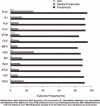Detection of viral and bacterial pathogens in hospitalized children with acute respiratory illnesses, Chongqing, 2009-2013
- PMID: 25906103
- PMCID: PMC4602679
- DOI: 10.1097/MD.0000000000000742
Detection of viral and bacterial pathogens in hospitalized children with acute respiratory illnesses, Chongqing, 2009-2013
Abstract
Acute respiratory infections (ARIs) cause large disease burden each year. The codetection of viral and bacterial pathogens is quite common; however, the significance for clinical severity remains controversial. We aimed to identify viruses and bacteria in hospitalized children with ARI and the impact of mixed detections.Hospitalized children with ARI aged ≤16 were recruited from 2009 to 2013 at the Children's Hospital of Chongqing Medical University, Chongqing, China. Nasopharyngeal aspirates (NPAs) were collected for detection of common respiratory viruses by reverse transcription polymerase chain reaction (RT-PCR) or PCR. Bacteria were isolated from NPAs by routine culture methods. Detection and codetection frequencies and clinical features and severity were compared.Of the 3181 hospitalized children, 2375 (74.7%) were detected with ≥1 virus and 707 (22.2%) with ≥1 bacteria, 901 (28.3%) with ≥2 viruses, 57 (1.8%) with ≥2 bacteria, and 542 (17.0%) with both virus and bacteria. The most frequently detected were Streptococcus pneumoniae, respiratory syncytial virus, parainfluenza virus, and influenza virus. Clinical characteristics were similar among different pathogen infections for older group (≥6 years old), with some significant difference for the younger. Cases with any codetection were more likely to present with fever; those with ≥2 virus detections had higher prevalence of cough; cases with virus and bacteria codetection were more likely to have cough and sputum. No significant difference in the risk of pneumonia, severe pneumonia, and intensive care unit admission were found for any codetection than monodetection.There was a high codetection rate of common respiratory pathogens among hospitalized pediatric ARI cases, with fever as a significant predictor. Cases with codetection showed no significant difference in severity than those with single pathogens.
Conflict of interest statement
BJC consults for Crucell NV. The other authors have no conflicts of interest to disclose.
Figures


Similar articles
-
[Etiology of acute respiratory tract infection in hospitalized children in Suzhou from 2005 to 2011].Zhonghua Yu Fang Yi Xue Za Zhi. 2013 Jun;47(6):497-503. Zhonghua Yu Fang Yi Xue Za Zhi. 2013. PMID: 24113096 Chinese.
-
[Viral etiology of acute respiratory tract infection among pediatric inpatients and outpatients from 2010 to 2012 in Beijing, China].Zhonghua Er Ke Za Zhi. 2013 Apr;51(4):255-9. Zhonghua Er Ke Za Zhi. 2013. PMID: 23927797 Chinese.
-
Prevalence and distribution of respiratory pathogens in pediatric acute respiratory infections in Putian, China.BMC Infect Dis. 2025 Feb 26;25(1):278. doi: 10.1186/s12879-025-10670-7. BMC Infect Dis. 2025. PMID: 40012061 Free PMC article.
-
Rethinking Paediatric Respiratory Infections: The Role of Mixed Pathogen Infections.Rev Med Virol. 2025 Mar;35(2):e70021. doi: 10.1002/rmv.70021. Rev Med Virol. 2025. PMID: 40000823 Review.
-
Viral respiratory diseases in children: classification, etiology, epidemiology, and risk factors.J Pediatr. 1994 May;124(5 Pt 2):S13-6. doi: 10.1016/s0022-3476(94)70185-7. J Pediatr. 1994. PMID: 8169752 Free PMC article. Review.
Cited by
-
Retrospective study of prognostic factors in pediatric invasive pneumococcal disease.PeerJ. 2017 Jan 25;5:e2941. doi: 10.7717/peerj.2941. eCollection 2017. PeerJ. 2017. PMID: 28149700 Free PMC article.
-
Streptococcus pneumoniae colonization of the nasopharynx is associated with increased severity during respiratory syncytial virus infection in young children.Respirology. 2018 Feb;23(2):220-227. doi: 10.1111/resp.13179. Epub 2017 Sep 15. Respirology. 2018. PMID: 28913912 Free PMC article.
-
Evaluation of TaqMan Array card (TAC) for the detection of 28 respiratory pathogens.BMC Infect Dis. 2020 Nov 10;20(1):820. doi: 10.1186/s12879-020-05562-x. BMC Infect Dis. 2020. PMID: 33172401 Free PMC article.
-
Viral etiology of severe lower respiratory tract infections in SARS-CoV-2 negative hospitalized patients during the COVID-19 pandemic in Kuwait.Heliyon. 2024 Apr 17;10(8):e29855. doi: 10.1016/j.heliyon.2024.e29855. eCollection 2024 Apr 30. Heliyon. 2024. PMID: 38681623 Free PMC article.
-
Epidemiological characteristics and meteorological factors of acute respiratory infections (ARIs) in hospitalized children in eastern Guangdong, China.Sci Rep. 2024 Oct 26;14(1):25518. doi: 10.1038/s41598-024-77005-5. Sci Rep. 2024. PMID: 39462026 Free PMC article.
References
-
- The Acute Respiratory Infections Atlas. 2010. http://www.ariatlas.org/understanding_aris Accessed September 15, 2014.
-
- Schaffer K, La Rosa AM, Whimbey E. Cohen J, Powderly WG, Opal SM. Respiratory viruses. Infectious Diseases 3rd ed. Philadelphia, PA: Mosby/Elsevier Medicine, 2010.
-
- Black RE, Cousens S, Johnson HL, et al. Global, regional, and national causes of child mortality in 2008: a systematic analysis. Lancet 2010; 375:1969–1987. - PubMed
-
- WHO. The global burden of disease: 2004 update. Geneva, Switzerland: World Health Organization; 2008.
Publication types
MeSH terms
LinkOut - more resources
Full Text Sources
Medical

